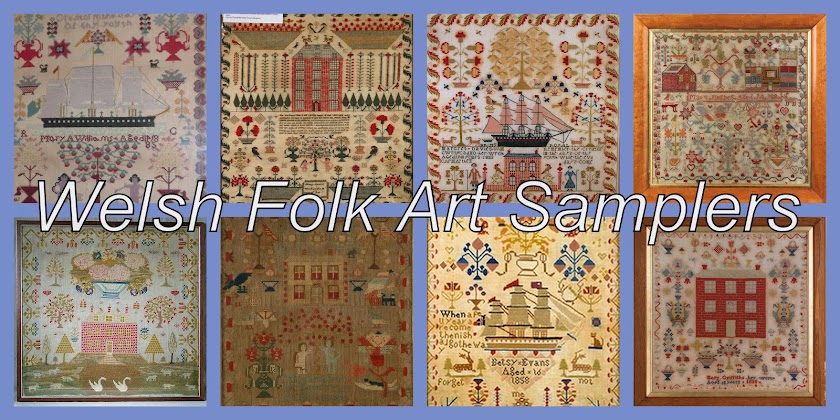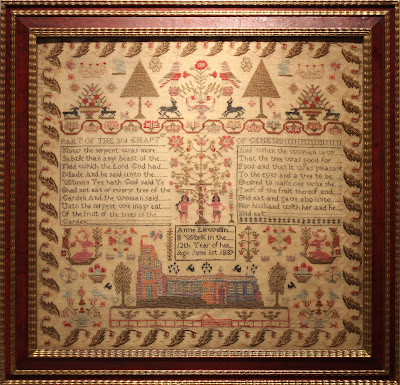I have reworked a post which was published earlier in the year on my Little Welsh Quilts blog. This blog was then just a vague idea, had it been up an running, this post would have been there!
My grandmother was born Mary Evans, which is a name quite commonly found on Welsh samplers and because I can't resist a sampler with her name I have a few in my collection. Although I no longer buy, this sampler in an on-line auction earlier this year, immediately caught my attention -
It was listed as American, though I am perfectly certain it's Welsh! I have seen so many Welsh samplers with that particular house as well as those robin type birds which are generally found on Carmarthenshire samplers. I will return to this group of samplers in a future post and go into the similarity of style in more detail.
On the same sampler trawl I found another -
This was also listed as American but again I am pretty certain it's Welsh.
I am not really surprised to see British samplers listed as American because the antique trade isn't knowledgeable or interested in sampler history, they are in the business of getting the best price! There are a few top dealers who do their best to collect information to enhance a sale, but the of lack of well researched publications make it extremely difficult.
Of course as time goes by samplers are dispersed worldwide and stray far from their homeland, but somewhere in the USA someone maybe hanging one of the above samplers on their wall having paid an "American" price for a non American sampler! For as you may know, American samplers are priced more highly than British! Buyer beware!
My grandmother was born Mary Evans, which is a name quite commonly found on Welsh samplers and because I can't resist a sampler with her name I have a few in my collection. Although I no longer buy, this sampler in an on-line auction earlier this year, immediately caught my attention -
It was listed as American, though I am perfectly certain it's Welsh! I have seen so many Welsh samplers with that particular house as well as those robin type birds which are generally found on Carmarthenshire samplers. I will return to this group of samplers in a future post and go into the similarity of style in more detail.
On the same sampler trawl I found another -
This was also listed as American but again I am pretty certain it's Welsh.
I am not really surprised to see British samplers listed as American because the antique trade isn't knowledgeable or interested in sampler history, they are in the business of getting the best price! There are a few top dealers who do their best to collect information to enhance a sale, but the of lack of well researched publications make it extremely difficult.
Of course as time goes by samplers are dispersed worldwide and stray far from their homeland, but somewhere in the USA someone maybe hanging one of the above samplers on their wall having paid an "American" price for a non American sampler! For as you may know, American samplers are priced more highly than British! Buyer beware!

















